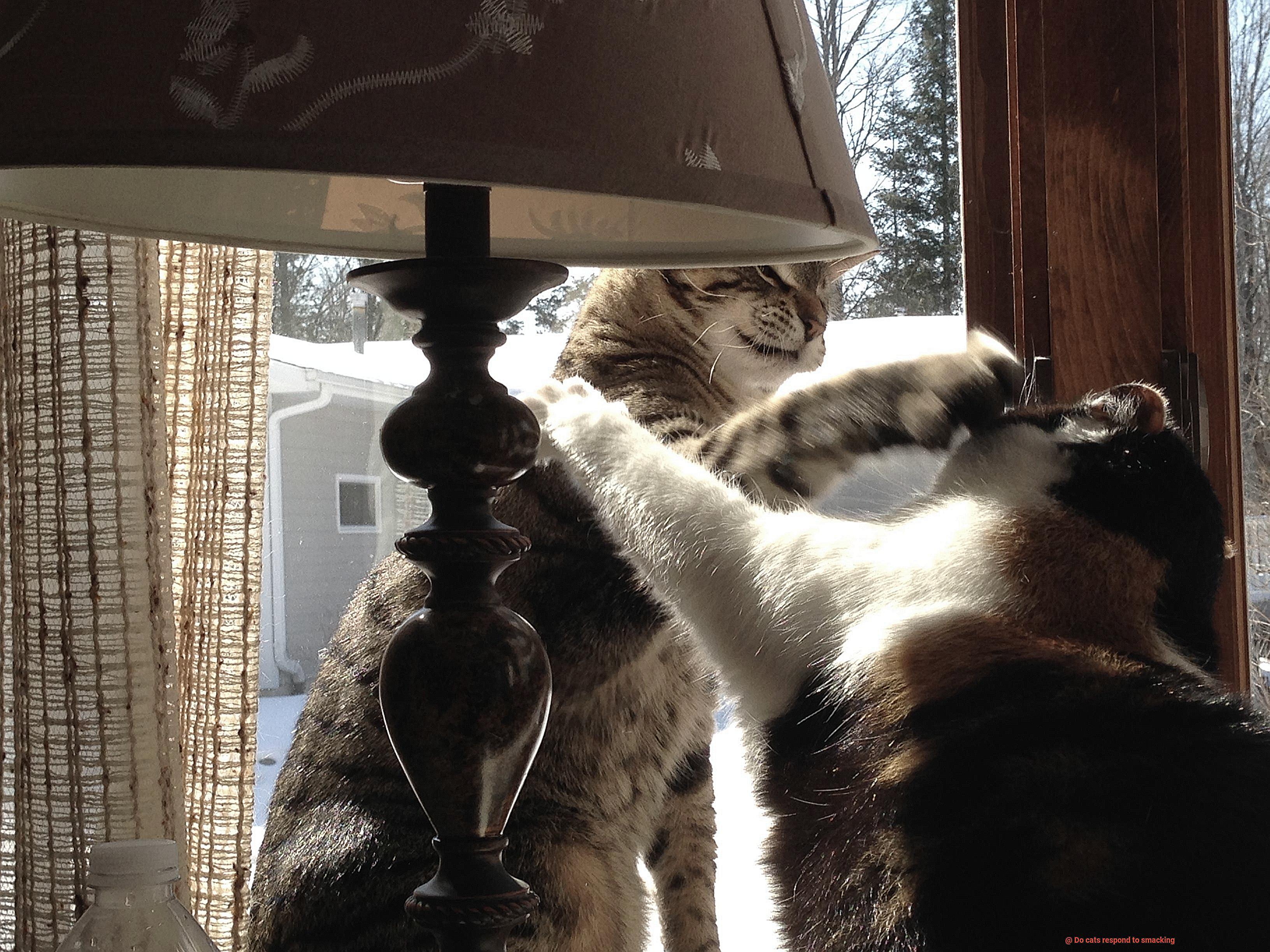As a cat owner, you know that our feline friends can be both delightful and frustrating. From knocking over your favorite vase to ignoring their litter box, cats have a knack for testing our patience. When faced with these challenges, it’s tempting to give them a quick smack on the nose as punishment. But, before you take action, it’s important to ask yourself: do cats respond to smacking?
The debate around physical discipline for cats is a contentious one that continues to divide animal lovers. Some believe that a small smack is an effective way to deter bad behavior, while others argue that it’s cruel and counterproductive. In this blog post, we’ll explore the science behind feline behavior and answer the burning question: should you be smacking your cat?
We’ll delve into the main points surrounding this topic, including the potential consequences of physical punishment, alternative methods for training your cat, and the importance of positive reinforcement. By the end of this post, you’ll have gained valuable insights into how your furry friend thinks and developed a greater appreciation for the power of kindness and patience in training.
So let’s get started. We’ll uncover the truth behind smacking cats and equip you with practical tips for managing your cat’s behavior without resorting to violence. With our guidance, you’ll learn how to build trust with your cat and create a harmonious relationship based on mutual respect.
What is Smacking?
While smacking may seem like a quick fix for unwanted behavior, it’s important to understand what it is and why it may not be the best method of training.
Smacking is a form of physical punishment that involves hitting someone with an open hand. It’s often used as a disciplinary measure for children, but some pet owners also use it to train their cats. Smacking can range from a light tap to a more forceful hit, depending on the severity of the behavior being corrected.
However, many animal behavior experts disagree with using physical punishment as a form of training. They argue that smacking can be harmful and may cause more behavioral issues in the long run. When a cat is smacked, they may stop engaging in the behavior that led to the smack, at least temporarily. However, this response can be short-lived and may not address the underlying cause of the behavior. In fact, smacking a cat can cause them to become fearful or aggressive towards their owner.
It’s important to note that smacking is not the same as play fighting, which is a natural behavior for cats. Play fighting involves mock battles between cats and is often accompanied by playful biting and scratching. Smacking, on the other hand, is a deliberate act of punishment that is intended to correct unwanted behavior.
So, what are some alternative methods of training your cat? Positive reinforcement techniques such as rewards for good behavior and redirecting unwanted behavior towards appropriate outlets have been proven effective. Clicker training and behavioral modification techniques are also great alternatives to physical punishment.

Do Cats Respond to Smacking?
When faced with undesirable behavior, it can be tempting to resort to physical punishment, such as smacking. However, before taking this approach, it’s important to consider whether or not cats respond well to smacking and if it’s an effective form of discipline.
Firstly, it’s essential to acknowledge that cats do not respond positively to physical punishment. While smacking may temporarily stop the unwanted behavior, it doesn’t teach them what they should be doing instead. In fact, it can cause fear and anxiety in cats, leading to further behavioral issues.
Moreover, smacking a cat can also cause physical harm. Cats have delicate bones and organs that can be easily injured by physical force. Additionally, a cat may retaliate with scratching or biting in self-defense, putting both the owner and the cat at risk.
Instead of resorting to smacking, cat owners should focus on positive reinforcement. This method involves rewarding good behavior with treats or affection rather than punishing bad behavior. Not only does positive reinforcement teach the cat what they should be doing, but it also strengthens the bond between the cat and owner.
The Pros and Cons of Smacking a Cat
While some may argue that a quick smack on the nose or behind can deter bad behavior, there are several reasons why this method is not recommended.

First and foremost, cats do not respond well to physical punishment. These intelligent creatures can quickly associate the physical pain caused by a smack with the person who administered it, leading to fear and distrust. This can be detrimental to the bond between you and your cat, making it difficult to establish a positive relationship.
Aside from emotional harm, smacking can also cause physical harm to your cat. Cats have delicate noses and sensitive ears, and a hard smack can cause pain and injury. It’s important to remember that cats are not like dogs – they do not respond well to dominance-based training methods.
On the other hand, using positive reinforcement techniques instead of smacking is highly recommended. Consistency and routine are key when it comes to training cats. By providing positive reinforcement for good behavior, your furry friend will be more likely to repeat it. This can be done through treats or praise when they behave well.
The use of positive reinforcement has several advantages over smacking. Firstly, it teaches your cat what they should be doing instead of the undesirable behavior. Secondly, it strengthens the bond between you and your furry friend since you’re rewarding them for doing something good.
Alternatives to Smacking a Cat
However, resorting to smacking is never the answer. Not only is it cruel and ineffective, but it can also harm the bond between you and your cat. Luckily, there are plenty of alternatives to smacking that can be just as effective and humane.
The first alternative is to use positive reinforcement. This technique involves rewarding good behavior with treats, praise, or playtime. If your cat uses their scratching post instead of the couch, reward them with a treat or some extra playtime. Positive reinforcement not only prevents negative behaviors but also strengthens the bond between you and your cat, creating a happy and healthy relationship.
The second alternative is redirection. This approach entails redirecting your cat’s attention away from undesirable behavior and towards something more appropriate. For example, if your cat is scratching the carpet, redirect them to a scratching post or toy. This not only stops the negative behavior but also teaches your cat what is acceptable, making them more well-behaved in the long run.
Environmental modifications can also be an effective alternative to smacking. This involves making changes to your cat’s environment that discourage negative behaviors. For instance, if your cat is jumping on counters, you can put double-sided tape or aluminum foil on the counters to make them less appealing. Besides stopping negative behavior, environmental modifications also create a more comfortable environment for both you and your cat.
In some cases, ignoring negative behavior may be an effective alternative. Cats crave attention, even if it’s negative attention. If your cat is engaging in a negative behavior for attention, ignoring them can teach them that this behavior will not get them what they want. This approach may take patience and time, but it can ultimately result in better behavior.
Lastly, seeking professional help from a veterinarian or animal behaviorist can be an effective alternative to smacking. They can provide guidance on how to modify your cat’s behavior and may recommend medication or other treatments if necessary. Professional help can often provide solutions that you may not have thought of, and it can ultimately lead to a happier and better-behaved cat.
How to Discipline a Cat Without Physical Punishment

While some people may think that physical punishment is an effective way to discipline cats, research has shown that this approach is not only cruel but also counterproductive. So what can you do to discipline your cat without resorting to physical punishment? In this post, we will explore five positive reinforcement techniques that can help you encourage good behavior in your furry friend.
Clicker Training
Clicker training is a popular method of positive reinforcement that involves using a clicking sound to mark a desirable behavior followed by a reward such as a treat or praise. This method teaches cats to associate good behavior with positive outcomes, making them more likely to repeat it in the future. Clicker training is a great way to train your cat to perform tricks, follow commands, or stop engaging in unwanted behaviors.
Redirection

Another effective method of disciplining cats without physical punishment is redirection. This involves providing an alternative activity that is acceptable to the cat and redirecting their attention away from the unwanted behavior. For example, if your cat is scratching the furniture, provide them with a scratching post or pad as a more appropriate outlet for their natural urge to scratch.
Enrichment
Cats require an enriched environment that meets their physical and mental needs. Providing them with plenty of toys, scratching posts, perches, and hiding spots can go a long way in preventing bad behavior. A bored or stressed cat is more likely to engage in destructive behavior, so it’s important to keep them mentally stimulated.
Consistency
Consistency is key when it comes to disciplining cats. Set clear boundaries and rules for behavior and be sure to follow through with consequences for breaking them. Cats thrive on routine and consistency, so by setting clear expectations and consistently enforcing them, you can help prevent bad behavior from occurring.
Positive Reinforcement
Finally, positive reinforcement is a great way to encourage good behavior in cats. This involves rewarding your cat for good behavior rather than punishing them for bad behavior. For example, if your cat uses the litter box correctly, give them a treat or praise them with verbal affirmations. Positive reinforcement reinforces desirable behaviors and helps to build a strong bond between you and your furry friend.
Conclusion
In conclusion, the debate over whether cats respond to smacking is still ongoing among animal lovers. While some might argue that physical punishment can be an effective way to correct bad behavior in cats, others believe it’s cruel and counterproductive. As a responsible cat owner, it’s essential to understand the potential consequences of using physical punishment and explore alternative training methods.
Positive reinforcement techniques such as rewarding good behavior, redirection, environmental modifications, and clicker training have been proven to be more effective than violence when it comes to disciplining cats. Consistency and routine are crucial in training your feline friend. By providing positive reinforcement for desirable behaviors, your furry companion will be more likely to repeat them.
It’s worth noting that smacking a cat can cause fear and anxiety in them, leading to further behavioral problems. Additionally, physical harm can result since cats have delicate bones and organs that can be easily injured by physical force. Instead of resorting to smacking or hitting your cat, you should focus on building trust with kindness and patience.
To sum up, understanding your pet’s thought process and developing an appreciation for positive reinforcement in training will help create a harmonious relationship based on mutual respect with your beloved feline friend.

